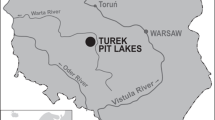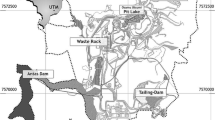Abstract
Reservoirs of anthropogenic genesis are a special component of the technogenic landscape. Their environmental conditions differ from those of natural water bodies. Such differences include a limited catchment area and a low thickness of bottom sediments, as well as high contents of metals, metalloids, and salts. The objects of our research are various lake formations that formed during the development of mineral deposits in the Eastern Transbaikal region. This article describes the chemical composition of the waters and the species diversity and the structure of hydrobiont communities that are different in their formation and purpose of technogenic reservoirs of mining areas. Algae and zooplankton of technogenic water bodies in a region with an arid climate have been studied for the first time. The studied waters have a variety of morphometric and physicochemical characteristics with a wide range of pH values (2.99–8.80), total mineralization (85.9–9065 mg/L), and content of ore and associated elements. According to the chemical composition, the waters are sulphate and bicarbonate-sulphate, with different ratios of magnesium and calcium. The species diversity of the algae and zooplankton of the studied water bodies is low (75 taxa of plankton algae, 8 taxa of macroalgae, and 63 species and subspecies of plankton invertebrates). This is associated with extreme environmental conditions, where species richness is influenced by physicochemical conditions of the habitat. The determining factors for the development of Cryptophyta representatives are micro- and macrocomponent composition and general mineralization, for other groups of phytoplankton (Cyanobacteria, Bacillariophyta, Chrysophyta, Charophyta, Chlorophyta, Euglenophyta, and Dynophyta) it was the content of bicarbonates. Quantitative indicators of zooplankton are positively related to the concentration of ammonium nitrogen (for Crustacea) and negatively to pH (Rotifera).


Similar content being viewed by others
REFERENCES
Afonina, E.Yu. and Itigilova, M.Ts., Species composition of Rotifera and crustaceous of the Shilka river basin, Zap. Zabaik. Otdel. Geogr. O-va, 2012, no. 131, pp. 40–51.
Afonina, E.Yu., and Afonin, A.V., Fauna of fishes and planktonic invertebrates in some tributaries of the upper Onon river (Zabaikalsky krai), Amur. Zool. Zh., 2015, vol. VII, no. 1, pp. 3–13.
Afonina, E.Yu. and Afonin, A.V., Assessment of hydrobiocenoses in the small rivers of Argun river basin, Teoreticheskaya i Prikladnaya Ekologiya, 2017, no. 3, pp. 57–65.
Balushkina, E.V. and Vinberg, G.G., Relationship between length and body weight of planktonic crustaceans, in Eksperimental’nye i polevye issledovaniya biologicheskikh osnov produktivnosti ozer (Experimental and Field Studies of the Biological Foundations of Lake Productivity), Vinberg, G.G., Ed., Leningrad: Nauka, 1979, pp. 58–79.
Beulker, C., Lessmann, D., and Nixdorf, B., Aspects of phytoplankton succession and spatial distribution in an acidic mining lake (Plessa 117, Germany), Acta Oecologica, 2003, vol. 24, pp. 25–31.
Bielańska-Grajner, I., and Gładysz, A., Planktonic rotifers in mining lakes in the Silesian Upland: relationship to environmental parameters, Limnologica, 2010, vol. 40, pp. 67–72.
Blanchette, M.L. and Lund, M.A., Pit lakes are a global legacy of mining: An integrated approach to achieving sustainable ecosystems and value for communities, Current Opinion in Environmental Sustainability, 2016, vol. 23, pp. 28–34.
Chechel’, L.P., Formation of hydrogeochemical fields of tungsten deposits in Eastern Transbaikalia under the influence of natural and anthropogenic factors, Cand. Sci. (Geol.-Mineral.) Dissertation, Chita: Inst. Prorodnykh Resursov, Ekologii I KriologiiI Sibirskogo Otdeleniya Ross. Akad. Nauk, 2020.
Chechel’, L.P. and Zamana, L.V., Main geochemical types of drainage waters of tungsten deposits in Southeast Transbaikalia, Vestn. Tomsk. Gos. Univ., 2009, no. 329, pp. 271–277.
Deneke, R., Review of rotifers and crustaceans in highly acidic environments of pH values ≤ 3, Hydrobiologia, 2000, vol. 433, pp. 167–172.
El-Bassat, R.A. and Taylor, W.D., The zooplankton community of Lake Abo Zaabal, a newly-formed mining lake in Cairo, Egypt, Afr. J. Aquat. Sci., 2007, vol. 32, no. 2, pp. 1–8.
Ferrari, C.R., de Azevedo, H., Wisniewski, M.J.S., Rodgher, S., Roque, C.V., and Nascimento, M.R.L., An overview of an acidic uranium mine pit lake (Caldas, Brazil): Composition of the zooplankton community and limnochemical aspects, Mine Water Environ., 2015, vol. 34, pp. 343–351.
Gabyshev, V.A. and Gabysheva, O.I., On the study of the effects of heavy metals on the growth of lake phytoplankton in Yakutsk and its vicinity, Prirodnye Resursy Arktiki i Subarktiki, 2020, vol. 25, no 4, pp. 81–91.
Gammons, C.H., Harris, L.N., Castro, J.M., Cott, P.A., and Hanna, B.W., Creating lakes from open pit mines: Processes and considerations – with emphasis on northern environments, Canadian Technical Report of Fisheries and Aquatic Sciences 2826. http://digitalcommons.mtech.edu/geol_engr/2. Cited April 13, 2022.
Goździejewska, A.M., Koszałka, J., Tandyrak, R., Grochowska, J., and Parszuto, K., Functional responses of zooplankton communities to depth, trophic status, and ion content in mine pit lakes, Hydrobiologia, 2021, vol. 848, pp. 2699–2719.
Grishchenko, N.S., Klassifikatsiya antropogennykh vodoemov po urovnyu tekhnicheskogo obustroistva (tekhnizirovannosti) (Classification of Anthropogenic Reservoirs According to the Level of Technical Arrangement (Technicalization)), Moscow: Melioratsiya i Vodnoe Khozyaistvo, 1999.
Guiry, M.D. and Guiry, G.M., AlgaeBase. http://www.algaebase.org. Cited November 20, 2021.
Kalin, M., Cao, C., Smith, M.P., and Olaveson, M.M., Development of the phytoplankton community in a pit-lake in relation to water quality changes, Water Res., 2001, vol. 35, no. 13, 3215–3225.
Kiselev, I.A., Plankton morei i kontinental’nykh vodoemov (Plankton of the Seas and Continental Waters), Leningrad: Nauka, 1969, vol. 1.
Kopyrina, L.I., Structure and species composition of algae of technogenic reservoirs (Anabar river basin, North-West Yakutia), Sovremennye Problemy Nauki i Obrazovaniya, 2016, no. 4, pp. 207–213.
Kuklin, A.P., Macroscopic algae in the reservoirs of the Sokhondinsky Reserve and the protected zone, in Sbornik trudov Sokhondinskogo zapovednika issledovaniya v okhrannoi zone (Proc. Sokhondinsky Reserve Research in the Buffer Zone), Chita: Ekspress-Izdatel’stvo, 2014, pp. 31–43.
Kumar, R.N., McCullough, C.D., and Lund, M.A., Water resources in Australian mine pit lakes, Min. Technol., 2009, vol. 118, pp. 205–211.
Leppänen, J.J., An overview of cladoceran studies conducted in mine water impacted lakes, Int. Aqua. Res., 2018, vol. 10, pp. 207–221.
Lessmann, D., Fyson, A., and Nixdorf, B., Phytoplankton of the extremely acidic mining lakes of Lusatia (Germany) with pH ≤ 3, Hydrobiologia, 2000, vol. 433, pp. 123–128.
Moser, M. and Weisse, T., The most acidified Austrian lake in comparison to a neutralized mining lake, Limnologica, 2011, vol. 41, pp. 303–315.
Nixdorf, B., Fyson, A., and Krumbeck, H., Review: Plant life in extremely acidic waters, Environ. Exp. Bot., 2001, vol. 46, 203–211.
Nixdorf, B., Krumbeck, H., Jander, J., and Beulker, C., Comparison of bacterial and phytoplankton productivity in extremely acidic mining lakes and eutrophic hard water lakes, Acta Oecologica, 2003, vol. 24, pp. 281–288.
Paulsson, O. and Widerlund, A., Algal nutrient limitation and metal uptake experiment in the Åkerberg pit lake, Northern Sweden, Appl. Geochem., 2021, vol. 125, p. 104829.
Pociecha, A., Bielańska‑Grajner, I., Szarek-Gwiazda, E., Wilk‑Woźniak, E., Kuciel, H., and Walusiak, E., Rotifer diversity in the acidic pyrite mine pit lakes in the Sudety Mountains (Poland), Mine Water Env., 2018, vol. 37, pp. 518–527.
Ramanchuk, A.I., Makarevich, T.A., Khomitch, S., Machowski, R., Rzetala, M.A., and Rzetala, M., Methodological approaches to phytomediation of productive processes in chalk quarry reservoirs of Belarus, Ecol. Indic., 2021, vol. 129, p. 107995.
Romanov, R.E., Ermolaeva, N.E., and Bortnikova, S.B., Evaluaiton of the effect of heavy metals on the plankton in the technogenic water reservoir, Khim. Interesakh Ustoich. Razvit., 2011, no 19, pp. 305–312.
Rönicke, H., Schultze, M., Neumann, V., Nitsche, C., and Tittel, J., Changes of the plankton community composition during chemical neutralization of the Bockwitz pit lake, Limnologica, 2010, vol. 40, pp. 191–198.
Ruttner-Kolisko, A., Suggestions for biomass calculation of plankton rotifers, Archiv für Hydrobiologie Beihefte: Ergebnisse der Limnologie, 1977, vol. 8, pp. 71–76.
Sadchikov, A.P., Metody izucheniya presnovodnogo fitoplanktona (Methods for Studying Freshwater Phytoplankton), Moscow: Universitet i Shkola, 2003.
Seckbach, J., Chapman, D.J., Garbary, D.J., Oren, A., and Reisser, W., Algae and cyanobacteria under environmental extremes: Final comments, in Algae and Cyanobacteria in Extreme Environments. Cellular Origin, Life in Extreme Habitats and Astrobiology, Seckbach, J., Ed., Dordrecht: Springer, vol. 11, pp. 783–786.
Sharov, A.N., Phytoplankton of cold-water lake ecosystems under the influence of natural and anthropogenic factors, Doctoral (Biol.) Dissertation, St. Petersburg: Scientific Research Center of Ecol. Security Russ. Acad. Sci., 2020.
She, Z., Pan, X., Wang, J., Shao, R., Wang, G., Wang, S., and Yue, Z., Vertical environmental gradient drives prokaryotic microbial community assembly and species coexistence in a stratified acid mine drainage lake, Water Res., 2021, vol. 206, p. 117739.
Shipunov, A.B., Baldin, E.M., Volkova, P.A., Korobeinikov, A.I., Nazarova, S.A., Petrov, S.V., and Sufiyanov V.G., Naglyadnaya statistika, ispol’zuem R! (Visual Statistics, Use R!), Moscow: DMK Press, 2014.
Skrzypczak, A.R. and Napiόrkowska-Krzebietke, A., Identification of hydrochemical and hydrobiological properties of mine waters for use in aquaculture, Aquaculture Reports, 2020, vol. 18, p. 100460.
Solodukhina, M.A., and Pomazkova, N.V., Landscapes of Sherlovogorskaya ore district of the Zabaikalsky Krai, Uspekhi Sovremennogo Estestvoznaniya, 2014, no. 9, pp. 70–78.
Udachin, V.N., Aminov, P.G., and Deryagin, V.V., Chemical composition of technogenic waters in quarry lakes of Bashkortostan, Bashk. Khim. Zh., 2008, vol. 15, no. 4, pp. 64–69.
Udachin, V.N., Aminov, P.G., Lonshchakova, G.F., and Deryagin, V.V., Distribution of physical and chemical parameters in quarry lakes of sulphide ore fields Blyavinskoye and Yaman-Kosinskoye (The South Urals), Vestn. Orenburgskogo Gos. Univ., 2009, no. 5, pp. 167–172.
Vodorosli. Spravochnik (Seaweed. Handbook), Vasser, S.P, Kondrat’ev, N.V, and Masyuk, N.P, Eds., Kyiv: Naukova Dumka, 1989.
Weithoff, G., Moser, M., Kamjunke, N., Gaedke, U., and Weisse, T., Lake morphometry and wind exposure may shape the plankton community structure in acidic mining lakes, Limnologica, 2010, vol. 40, pp. 161–166.
Wollmann, K., Deneke, R., Nixdorf, B., and Packroff, G., Dynamics of planktonic food webs in three mining lakes across a pH gradient (pH 2–4), Hydrobiologia, 2000, vol. 433, pp. 3–14.
WoRMS: World Register of Marine Species. http://www.marinespecies.org. Cited April 13, 2022.
Zamana, L.V. and Chechel’, L.P., Hydrogeochemical features of the zone technogenesis polymetallic deposits Southeastern Transbaikalia, Uspekhi Sovremennogo Estestvoznaniya, 2015, no. 1, pp. 33–38.
Zamana, L.V., Abramova, V.A., Khvostova, T.E., and Chechel’ L.P., Nitrogen compounds in technogenic waters of ore deposits of Transbaikal region, Gornyi Zh., 2020, no. 3, pp. 31–35.
Funding
The work was carried out within the framework of the State Assignment for Fundamental Scientific Research, State Registration No. 121032200070-2.
Author information
Authors and Affiliations
Corresponding author
Ethics declarations
Conflict of interests. The authors declare that they have no conflict of interest.
Additional information
Translated by T. Kuznetsova
Rights and permissions
About this article
Cite this article
Afonina, E.Y., Tashlykova, N.A., Zamana, L.V. et al. The Hydrochemistry and Hydrobiology of Technogenic Reservoirs at Mining Territories of the Southeastern Transbaikal Region. Arid Ecosyst 12, 505–515 (2022). https://doi.org/10.1134/S2079096122040023
Received:
Revised:
Accepted:
Published:
Issue Date:
DOI: https://doi.org/10.1134/S2079096122040023




